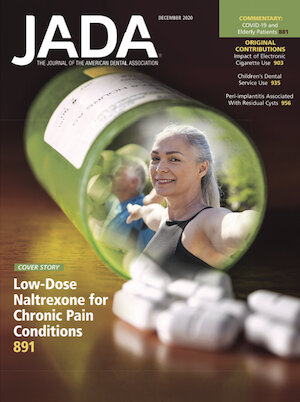NSAIDs Preferred for Acute Dental Pain
/By Pat Anson, PNN Editor
Nonsteroidal anti-inflammatory drugs (NSAIDs) taken alone or in combination with acetaminophen are recommended as first-line treatments for managing short-term acute dental pain in adults and adolescents aged 12 and older, according to a new guideline developed by the American Dental Association (ADA).
Opioid analgesics should only be used when NSAIDs and acetaminophen are insufficient to reduce pain or when NSAIDs are contradicted, according to the ADA guideline, which also warns dentists to avoid “just-in-case” opioid prescribing.
“Providing prescribing guidelines for acute dental pain management is an important step towards improving patient treatment and outcomes,” Marta Sokolowska, PhD, deputy center director for substance use and behavioral health at the FDA's Center for Drug Evaluation and Research, said in a press release. “We hope this clinical practice guideline will reduce the risk of opioid addiction, overdose and diversion.”
Opioids were once routinely prescribed to dental patients after a surgical tooth extraction or even a simple toothache. In 1998, dentists wrote 15.5% of all prescriptions for immediate release opioids in the United States. Many of those prescriptions are now considered high risk because the daily dose was over 50 MME (morphine milligram equivalents) or the amount prescribed exceeded a 3-day supply.
After reviewing 82 clinical trials involving tooth extractions, the ADA’s guideline panel found that NSAIDs were more effective than opioids in reducing post-operative pain.
“When managing acute dental pain, there are several reasons to consider alternatives to opioids. First, evidence suggests that opioids may not be the best approach to managing what is often inflammation-related acute dental pain. Nonsteroidal anti-inflammatory drugs (NSAIDs) would target the source of the pain, whereas opioids would not,” the guideline cautions.
Only in “rare instances” when pain control is inadequate with NSAIDs does the guideline recommend low doses of oxycodone or hydrocodone, in combination with acetaminophen. Opioids can also be used when NSAIDs are contradicted due to health issues, such as a patient having cardiovascular problems or a bleeding ulcer.
“When opioids are prescribed, clinicians should obtain informed consent from the patient (or the parent or guardian in the case of minors) with detailed information about potential opioid undesirable effects. This is particularly critical in adolescents and young adults who are at increased risk of subsequent misuse and substance use disorder even after a single prescription,” the guideline says.
This is the second of two ADA guidelines on acute dental pain management. A previous set of recommendations for pediatric patients under the age of 12 was published in 2023. It also recommends NSAIDs and acetaminophen as preferred analgesics. Opioids such as codeine and tramadol are not recommended for children under any circumstances.
The risk of long-term opioid use after a tooth extraction is relatively rare. A 2018 study of over 70,000 teens and young adults who had their wisdom teeth removed found that only 1.3% were still being prescribed opioids months after their initial prescription by a dentist.




